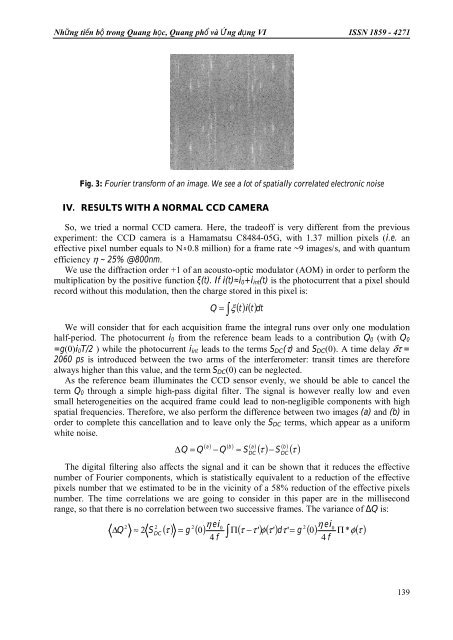Nhng tin b trong Quang hc, Quang ph và ng dng VI ISSN 1859 - 4271
Nhng tin b trong Quang hc, Quang ph và ng dng VI ISSN 1859 - 4271
Nhng tin b trong Quang hc, Quang ph và ng dng VI ISSN 1859 - 4271
You also want an ePaper? Increase the reach of your titles
YUMPU automatically turns print PDFs into web optimized ePapers that Google loves.
Nhữ<strong>ng</strong> tiến bộ <stro<strong>ng</strong>>tro<strong>ng</strong></stro<strong>ng</strong>> <stro<strong>ng</strong>>Qua<strong>ng</strong></stro<strong>ng</strong>> học, <stro<strong>ng</strong>>Qua<strong>ng</strong></stro<strong>ng</strong>> <stro<strong>ng</strong>>ph</stro<strong>ng</strong>>ổ và Ứ<strong>ng</strong> dụ<strong>ng</strong> <strong>VI</strong> <strong>ISSN</strong> <strong>1859</strong> - <strong>4271</strong>Fig. 3: Fourier transform of an image. We see a lot of spatially correlated electronic noiseIV. RESULTS WITH A NORMAL CCD CAMERASo, we tried a normal CCD camera. Here, the tradeoff is very different from the previousexperiment: the CCD camera is a Hamamatsu C8484-05G, with 1.37 million pixels (i.e. aneffective pixel number equals to N≈0.8 million) for a frame rate ~9 images/s, and with quantumefficiency η ~ 25% @800nm.We use the diffraction order +1 of an acousto-optic modulator (AOM) in order to perform themultiplication by the positive function ξ(t). If i(t)≈i 0 +i int (t) is the <stro<strong>ng</strong>>ph</stro<strong>ng</strong>>otocurrent that a pixel shouldrecord without this modulation, then the charge stored in this pixel is:∫Q = ξ( t) i( t)dtWe will consider that for each acquisition frame the integral runs over only one modulationhalf-period. The <stro<strong>ng</strong>>ph</stro<strong>ng</strong>>otocurrent i 0 from the reference beam leads to a contribution Q 0 (with Q 0=g(0)i 0 T/2 ) while the <stro<strong>ng</strong>>ph</stro<strong>ng</strong>>otocurrent i int leads to the terms S DC (τ) and S DC (0). A time delay δτ =2060 ps is introduced between the two arms of the interferometer: transit times are thereforealways higher than this value, and the term S DC (0) can be neglected.As the reference beam illuminates the CCD sensor evenly, we should be able to cancel theterm Q 0 through a simple high-pass digital filter. The signal is however really low and evensmall heterogeneities on the acquired frame could lead to non-negligible components with highspatial frequencies. Therefore, we also perform the difference between two images (a) and (b) inorder to complete this cancellation and to leave only the S DC terms, which appear as a uniformwhite noise.∆ Q = Q( a ) ( b ) ( a ) ( ) ( b− Q ≈ S τ − S ) ( τ )The digital filteri<strong>ng</strong> also affects the signal and it can be shown that it reduces the effectivenumber of Fourier components, which is statistically equivalent to a reduction of the effectivepixels number that we estimated to be in the vicinity of a 58% reduction of the effective pixelsnumber. The time correlations we are goi<strong>ng</strong> to consider in this paper are in the millisecondra<strong>ng</strong>e, so that there is no correlation between two successive frames. The variance of ∆Q is:22η eiη ei∆Q ≈ SDC4 f∫4 fDC2 02( τ ) = g ( 0) Π( τ −τ') φ( τ ') dτ' = g ( 0) Π * φ( τ )20DC139















